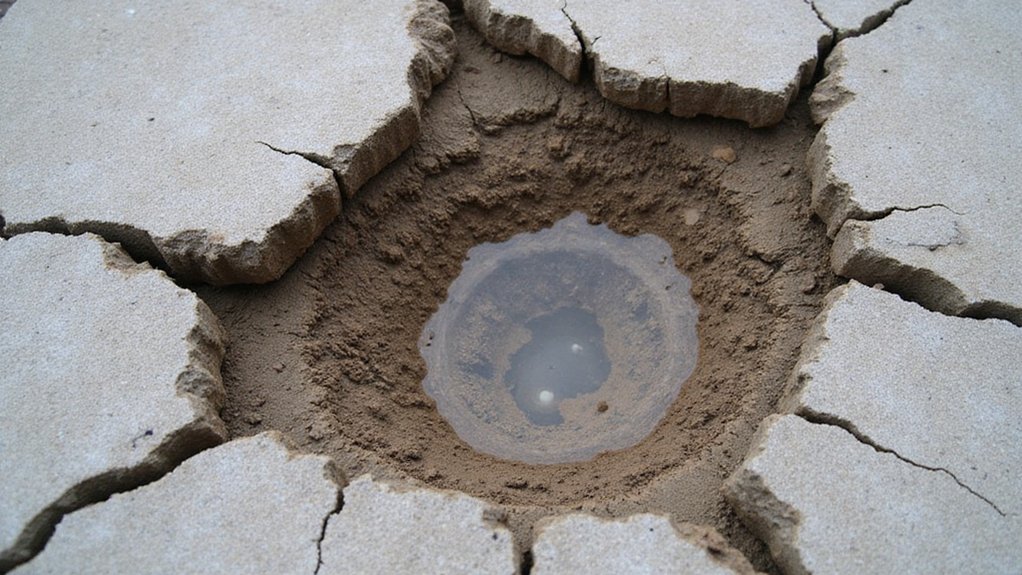Have you noticed water pooling around your home's foundation after rain? This seemingly minor issue could be silently destroying your property's structural integrity. Water doesn't just sit passively—it seeks pathways, erodes soil, and gradually weakens your foundation's stability. Uncontrolled drainage can cause soil expansion, create damaging pressure, and introduce hidden risks that might cost thousands in repairs. Want to understand how these subtle water movements threaten your home's foundation?
Understanding Water Flow Around Your Foundation
Since water always seeks the path of least resistance, understanding how it flows around your home's foundation is essential to preventing potential damage. Groundwater movement and surface water runoff can markedly impact your foundation's structural integrity. Poor yard drainage from improper land sloping can significantly increase the risk of foundation damage by directing excessive water toward your home's foundation walls. When rainwater or irrigation accumulates near your home, it can seep into the soil, creating pressure against foundation walls. This pressure can cause soil expansion, leading to cracks, shifting, and potential structural weakening. By monitoring drainage patterns and implementing proper landscaping techniques, you'll protect your home from costly water-related foundation issues.
Identifying Drainage Problem Warning Signs
If water damage threatens your home's foundation, knowing the early warning signs can save you thousands in repair costs. Drainage problems can silently undermine your property's structural integrity, causing significant damage before you realize it. Soil and grading issues can contribute to foundation damage if left unaddressed, potentially leading to costly repairs.
Excessive soil erosion near foundation walls
Standing water or muddy patches in your yard
Cracks in basement walls or foundation
Improper grading around home creating water pooling
Don't wait until it's too late. Catching these signs early can protect your home and prevent costly repairs.
Common Sources of Water Accumulation
Water accumulation around your home's foundation can stem from multiple critical sources that homeowners often overlook. Improper grading near your house can cause surface runoff to flow toward, instead of away from, your foundation. Gutters with clogged or misaligned downspouts frequently contribute to ground saturation, allowing water to pool dangerously close to structural walls.
Landscaping that doesn't account for proper drainage can also create moisture retention zones. Heavy rainfall, melting snow, and poor yard slope compound these risks, potentially causing significant foundation stress and long-term damage to your home's structural integrity.
Impact of Soil Composition on Water Drainage
Most homeowners don't realize that their foundation's vulnerability directly depends on the specific soil type surrounding their property. Your home's foundation faces unique challenges based on soil characteristics that impact water drainage and absorption:
- Clay soils retain more water, increasing pressure against foundation walls
- Sandy soils have higher soil porosity, allowing faster water drainage
- Loamy soils provide balanced water absorption and drainage capabilities
- Rocky soils create uneven water distribution and potential drainage challenges
Understanding your specific soil composition can help you proactively protect your home's structural integrity and prevent potential foundation damage.
Foundation Damage Mechanisms Caused by Poor Drainage
When inadequate drainage surrounds your home's foundation, several destructive mechanisms can compromise its structural integrity. Water pooling near your foundation can cause soil expansion and contraction, creating immense pressure that leads to cracks and shifting.
Improperly sized downspouts often contribute to this problem by directing excess water too close to your home's base. Inadequate grading can also worsen drainage issues, allowing water to collect and saturate the soil around your foundation.
These conditions can gradually weaken your home's structural support, potentially causing significant and costly damage that might require extensive repairs.
Preventative Drainage Strategies for Homeowners
Protecting your home's foundation from drainage-related damage starts with proactive planning and strategic interventions. You'll want to safeguard your property by implementing key drainage management techniques.
- Position downspouts to direct water at least 5 feet away from foundation
- Guarantee proper landscaping grading with a gentle slope away from your home
- Install French drains or underground drainage systems to control excess water
- Regularly inspect and maintain gutters to prevent water accumulation near foundation
These methods will help you protect your home's structural integrity and avoid costly repairs.
Professional Assessment and Repair Techniques
Every homeowner dreads foundation damage, which is why professional assessment and expert repair techniques are crucial for preserving your property's structural well-being.
When you suspect drainage issues, a qualified contractor can provide extensive on-site analysis to diagnose potential problems. They'll inspect your property's grading, examine foundation cracks, and evaluate water flow patterns around your home. Contractor feedback typically includes recommendations for targeted repairs, like installing French drains, regrading landscaping, or applying waterproof sealants.
Long-Term Foundation Protection and Maintenance
Most homeowners will need a strategic approach to preserve their foundation's long-term health, which requires consistent monitoring and proactive maintenance. By implementing smart strategies, you'll protect your home's structural integrity and prevent costly repairs.
Your foundation protection plan should include:
- Regular inspections every six months
- Maintaining proper terrain around your home
- Installing and cleaning gutters and downspouts
- Controlling soil moisture through strategic watering
Proper maintenance isn't just about preventing damage—it's about investing in your home's future and ensuring its stability for years to come.
Frequently Asked Questions
How Quickly Can Poor Drainage Cause Serious Foundation Damage?
You'll face serious foundation damage within 1-3 years if seasonal water pooling and increased soil erosion aren't addressed, compromising your home's structural integrity and long-term stability.
Can Landscaping Help Improve Drainage Around My Home's Foundation?
You can strategically use landscaping design to improve drainage around your foundation. Proper slope grading and drainage system maintenance will help redirect water away from your home's critical structural areas.
What Are the Estimated Repair Costs for Drainage-Related Foundation Issues?
Foundation repair costs can range from $2,000 to $30,000, depending on damage severity. You'll want a professional inspection ($300-$500) to accurately assess your specific drainage-related foundation issues.
Are Certain Home Foundations More Vulnerable to Drainage Problems?
Your home's foundation's vulnerability depends on its soil composition and construction materials. Clay soils and concrete foundations are more susceptible to drainage-related damage, making proper water management pivotal for your property's structural integrity.
How Do I Know if My Foundation Damage Is Drainage-Related?
You'll spot drainage-related foundation damage by checking your drainage history, observing soil composition shifts, and watching for cracks, uneven floors, and moisture near foundation walls.



